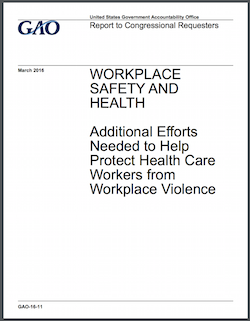
The Occupational Safety and Health Administration should take three steps to better protect healthcare workers, including those who work in residential care settings, from workplace violence, recommends a recent report from the U.S. Government Accountability Office.
“According to data from three federal datasets GAO reviewed, workers in healthcare facilities experience substantially higher estimated rates of nonfatal injury due to workplace violence compared to workers overall,” the GAO said, adding that the most common types of reported assaults were hitting, kicking and beating. “However, the full extent of the problem and its associated costs are unknown.”
First, the GAO recommends that OSHA provide additional information to assist its inspectors in developing citations, such as specific examples of issues that have been cited. “Without such additional information, inspectors may continue to experience difficulties in addressing the challenges they reported facing,” the GAO said.
Second, OSHA should develop a policy for following up on warning letters issued to employers related to workplace violence, which are issued when criteria for a citation have not been met, the GAO said. Doing so will clarify whether employers have addressed noted hazards and whether hazards still exist, according to GAO. Currently, employers are not required to take corrective action in response to the letters, and OSHA does not require inspectors to follow up to see whether employers have taken corrective actions.
Third, the GAO recommended, OSHA should develop and implement cost-effective ways to assess the results of the agency’s efforts to address workplace violence. “Without assessing these results, OSHA will not be in a position to know whether its efforts are effective or if additional action may be needed to address this hazard,” the GAO said.
OSHA agreed with the GAO’s recommendations and is taking action to address them, the GAO said. Specifically, OSHA is developing a training course to help inspectors and is revising its enforcement directive, which will include standardized procedures for following up on hazard alert letters. OSHA also told the GAO that it plans to determine whether it is necessary to develop a workplace violence prevention standard for healthcare workers, and that it is reviewing past inspections that resulted in citations or hazard alert letters to evaluate how these cases were developed and what measures may improve the process.



